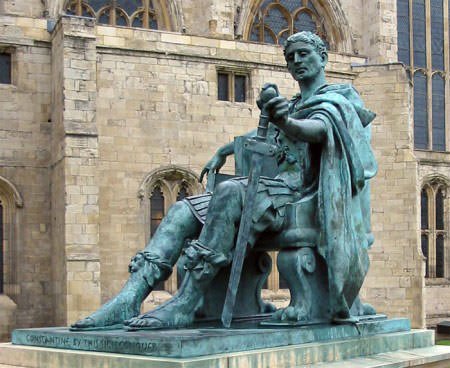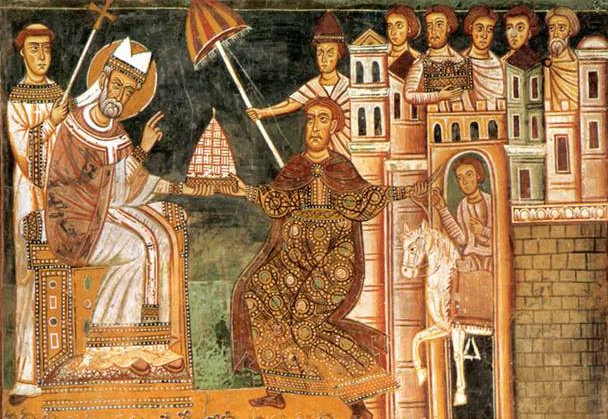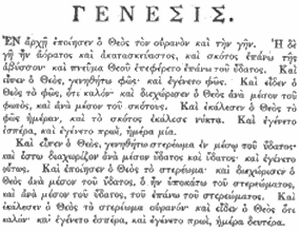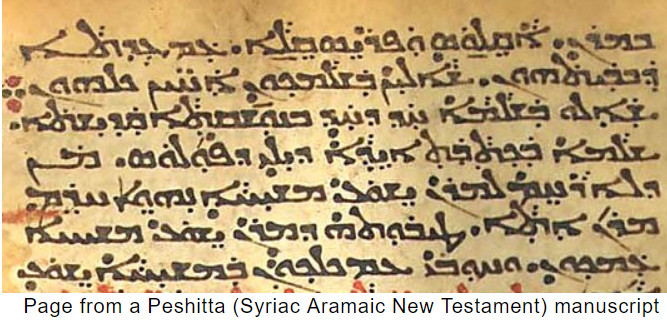
Notes on “The Story of the Bible” Class No. 4
Links to Other Classes
Previous Class:
No. 3
—
Next Class:
No. 5
—
Index
Preliminaries
Luke Timothy Johnson, Emory University, lecturer
Introductory Discussion and Information
Ancient Jewish History: Pharisees, Sadducees & Essenes
Lecture 7: Imperial Sponsorship and The Bible
Official outline from The Teaching Company
The story of The Bible is tied to the story of Judaism & Christianity
- it is shaped by world events
- this lecture explores how The Bible became “royal scripture”
The official religion of the Roman Empire was polytheism
- polytheism enjoyed patronage of the Emperor
- the Emperor consulted official prophecy, the auspices, every morning before making important decisions
- statues were dedicated to various gods and goddesses
- Emperor cult became an important part of social network
Jews and Christians did not have official patronage
- Christianity was persecuted
- Jews and Christians were equal rivals to polytheism
Dialog with Trypho
- writing by Justin Martyr (Christian philosopher) following his debate with a Trypho (Jewish scholar/teacher)
- 135 CE after the final destruction of Jerusalem and the failure of the Bar Kokhba Revolt
- part of debate was whether Jesus fulfilled the Messianic prophesies of the Torah
- Justin said yes, Trypho said no
- they also debated the versions of The Bible, that is, which was accurate and authoritative
- Justin said the Septuagint, Trypho said the Hebrew Bible
Rome was generous with cults
- Judaism was religio licita, that is, legitimate and respected
- Christianity was despised and persecuted
- there was an attempt to crush Christianity in the the early 4th cent. under Emperor Diocletian
After the 4th cent., Christianity takes over as the official religion of the Roman Empire
- turned pagan temples into Christian churches
- bishops became recognized as important in Imperial order
- Christianity laid claim to holy places in Palestine
- pilgrimages were organized to holy places
Judaism is increasingly marginalized
- seen as a threat to the order
- Jews refused to accept teachings
- Jews became defined as heretics
Christianity experienced severe debates
- orthodox Christianity found a place in the Imperial empire
- non-orthodox Christians had to find a place
 Thus, the relationship changed completely in the 4th century
Thus, the relationship changed completely in the 4th century
- the key figure was Constantine (274?-337)
- the photograph at the right is the bronze statue of Constantine I in York, England, near the spot where he was proclaimed Augustus in 306
- it is outside York Minster, a Gothic cathedral in York, North Yorkshire, which is the second largest Gothic cathedral of Northern Europe
- Theodocius I in 381 completed Constantine’s work
Constantine defeated Maxentius and credited his victory to Christ
- in hoc signo vinces = “in this sign you will conquer”
- he then adopted Labarum, a particular sign of the cross as his standard
“Life of Constantine” book by Eusebius
- Eusebius wrote that Constantine’s conversion was sincere
- Constantine was still regarded as a saint by Greek Orthodox
- Constantine may have seen Christianity as a better glue for the empire than paganism
- unity in religion is a large consideration because it contributes to peace
In 316, Constantine decided the Donatist dispute against schismatic Donatists and in favor of Catholics
- the Donatists in North Africa objected to accepting into Christianity those who survived persecution
- they only recognized those who resisted
- the Catholics were inclusive
In 325, Constantine called the Council of Nicea and chaired it himself
- he gathered bishops from around the world to develop a creed of what all Christians must believe
- Arias, from Alexandria, that Jesus was not fully divine and therefore should not be worshiped as God
- the result of the Council was that the word of God is truly divine
- “one in substance with the father”
Constantine also move his capital to Byzantium (present day Istanbul)
- this move was in in 330, 7 years before he died
- the Eastern Church, headed by the patriarch of Constantinople, would maintain Greek
- the Patriarch of Constantinople worked in close harmony with Emperor
- this close alignment of the patriarch and the Emperor yielded a political synthesis called Cesaro papism
- the Western part of empire became increasingly Latin
- differences became larger
- Augustine of Hippo, late 4th and early 5th cent., only Latin, no Greek
Things remained stable until 1453, when Constantine was besieged and fell to the Turks
- this resulted in increased power to West
 Donatio Constantini = Donation of Constantine
Donatio Constantini = Donation of Constantine
- forged (!) last will and testament of Constantine
- said that Constantine bequeathed Europe to the Pope
- accepted as authentic in Middle Ages
- in the 15th cent. there was realization that it could not possibly be genuine
Implications for The Bible
(1) Decisions of the Church councils had imperial backing
- the Pascal letter of Athanasius, in 367, set which compositions belong in The Bible
- the Council of Carthage, in 397, set the canon of Scripture
(2) Constantine put his imperial scribe to work on The Bible as a true book
- first appearance as a real book
- all of revelation was now between two covers
- The Bible itself becomes a religious object
(3) The Bible is now the official document of the State
Old vs. New Testament
- the prophecy vs. the fulfillment
- the inherent structure of the The Bible as a book represented the Old to New as development, that is, the New supersedes the Old
Supersession = the replacement of one by the other
- Christian conviction that history has proven them right
- the also found proof in that the religion becoming official religion of the empire
- thus, what do we make of the Jews?
- this yields to anti-Semitism
In contrast, the Jewish Bible is liberated
- read by Diaspora people as a purely religious text, not as a political text
- read not as a divine history, but as a divine commandments for the obligations of Jews
Discussion
“The struggle is still with us today.”
Some blame anti-Semitism as directly attributable to the early teachings of the Church.
Lecture 8: Texts and Translations — The Ancient East
Official outline from The Teaching Company
When talking about The Bible, we must clarify which version we’re talking about
Unlike the position of Islam with regard to the Koran in which only the Arabic version is holy, Jews and Christians have canonized stories rather than languages
 Jewish Bible has 3 ancient versions in addition to the original Hebrew
Jewish Bible has 3 ancient versions in addition to the original Hebrew
- Septuagint, 250 BC
- three translations into Greek by Theodotion, Symmachus, and Aquila
- 2nd cent. effort to replace the “tainted” Septuagint that was co-opted by the Christians
- Targums (Aramaic) began in oral tradition
- eventually reached written form
There is also a 10th cent. version in Arabic by Saadia Ben Joseph
- this version was created at a time when Islam was on the rise
- Islam was seen as a rival religious movement
Development of the Christian Bible is very different
The translations provide important knowledge of three kinds
- we gain knowledge of the receptor language (the language that The Bible is translated into)
- in some cases they had to invent the alphabet
- these are sometimes our earliest knowledge of those languages
- we gain knowledge of people outside the Empire who didn’t speak Greek
- Syria, Iran, the Slavic lands, Central Asia
- gain knowledge of how The Bible is understood in different cultures
- nuances always appeared, shedding light on cultures
These are important because these represent a witness to the text that is more ancient than the Greek versions
Syriac is a northwest Semitic language with 22 consonants and no vowels
- this is present day Syria and present day Iraq
- Syriac is a Semitic language, that is, cognate to Hebrew and Aramaic (that is, having the same root)
- the New Testament relates how Christianity came to Antioch, the center of Hellenistic culture
- Acts 11 tells us that there the Gospel was first proclaimed to non-Christians
- it also tells us that this is where Christians were first called hoi christainoi, that is, “Christians”
- Acts 13 tells us that the church in Antioch sponsored Paul and Barnabas in the first missionary journey
- Acts of the Apostles tells us nothing about how Christianity spread East
Edessa = modern Urpha in Turkey
- Ecclesiastical History in Greek by Eusebius
- The Doctrine of Adai
- legend has it that Thaddeus, who was sent by Jesus, spread the word
Arbella located east of the Tigris river
- by legend converted by Adai
- evangelization also took place in the countryside
- by 2nd cent. there were 20 bishoprics in the Tigris-Euphrates valley on the border of Persia
- thus, Christianity extended deep into present-day Iraq and to the border of Iran
Titian, an ascetic teacher, mid 2nd cent.
- he was Syrian, but he wrote in Greek
- Acts of Thomas and Gospel of Thomas are both very ascetic
- they imply that to be Christian meant to be ascetic
- asceticism preached that after baptism all sex must cease
- it was very divisive
By contrast West Syria, under the Byzantine Empire, was Monphysite
- Monphysite = emphasize Jesus’s divinity and deprecate His humanity
- Nestorian = emphasize Jesus’s humanity, somewhat to the denial of Jesus’s divinity
- both were condemned as heresy in their extreme form
- complexities were made worse by translations
The Diatessaron Version, written by Tatian
- weaves together four versions of the Gospels into one in Syriac
- discovered in 1930s
- written in Greek
In 19th cent., two manuscripts were discovered containing a Syriac version of the four Gospels
- non-standard sequence: Matthew, Mark, John, Luke
- as opposed to: Matthew, Mark, Luke, John as now accepted
 Peshitta Version
Peshitta Version
- supplanted Diatessaron
- meaning debated
- “simple” vs. “standard”
- New Testament had only 22 books, smaller than the Greek version
- Old Testament portion may have been translated by Jews, because it seems to show influence of Targums
- widely circulated and used by the 5th cent. in Syriac-speaking world
Philoxenian (or Harclean) Version
- translated by Bishop Philoxensys 508 CE
- revised in 616 by Thomas Harkel, from whom the term Harclean comes
- found in only a very few manuscripts
Palestinian Syriac Version, 300-600 CE
- misnamed, as it is really in Aramaic using Syriac letters
Looking at these versions as a whole, we see a progression from literal to more idiomatic versions
- Semitic languages are more limited than Greek
- Greek uses participles and prepositional phrases
- allows subordinate clauses which allow subtle sentences
Coptic translations
- provide earliest information on Christianity in ancient Egypt
- best known in its Hellenistic guise in Alexandria
- Alexandria was the Greek-speaking center that produced Septuagint
- the native population of Egypt spoke Coptic language
- the term copt derives from an Arabic corruption of the Greek Aigyptoi, which means “those Egyptians”
- Coptic incorporates Greek words
- alphabet used 24 Greek letters + 7 letters for spoken Coptic
The upper Nile was a center for Monastic life
- proof = Coptic books writings “Lives of Saints” and “Sayings of the Fathers”
- Egyptian church was therefore isolated until it was captured by the Persians in 616 and then by the Arabs in 642
The New Testament was translated into several dialects of Coptic
- 150-200 = preliminary stage, translations based on oral tradition, similar to Targums
- 200-250 = pre-classical Sahidic stage, translations of several Gospels
- 3rd cent. = classical Sahidic stage, complete Bible translated into Sahidic and Bohairic
- 4th-6th cent. = pre-classical Bohairic stage, translation from Sahidic to other Coptic dialects
- 6th-7th cent. = classical Bohairic stage, Christianity penetrated all of Egypt
 Gnostic Library of Nag Hammadi discovered 1945
Gnostic Library of Nag Hammadi discovered 1945
Coptic also has limitations
- less flexible than Greek to express emphasis by word order
- word order is more strict in Coptic than in Greek
- Coptic has no neuter gender, just masculine and feminine
- thus, the holy spirit in Greek is neuter, but in Coptic it must be masculine
Extensive Christian literature developed in both Greek and Syriac
- few original Coptic writings
- Shenoute (4th cent.) was an exception
- he was an Abbott who wrote letters, sermons, and apocalypses
- in contrast, Syriac writings were extensive
- Aphraates (270-335) wrote “23 Demonstrations on Faith“
- Ephraem (306-373) wrote commentaries on The Bible, doctrines, and pieces on asceticism
- Bar Hebraeus (1226-1286) is the last great Syriac writer
- also known as Abu al-Faraj
- in all likelihood he was a converted Jew
- he wrote the inherited wisdom of the ages in both Syriac and Arabic
In sum, these early translations point to a vibrant Christian life outside the Roman empire
Discussion
- The Bible didn’t begin here and end there, it developed over time
- that development seems similar to geography (or perhaps geology): what we see wasn’t always that way it was
- but it’s also political science and semantic
- the Coptic Church was very strong, but is being wiped out
Jewish prayers are virtually all in Hebrew except the Mourner’s Kaddish, which is in Aramaic
- Mourner’s Kaddisg in Aramaic
אבל: יִתְגַּדַּל וְיִתְקַדַּשׁ שְׁמֵהּ רַבָּא. [קהל: אמן]
בְּעָלְמָא דִּי בְרָא כִרְעוּתֵהּ וְיַמְלִיךְ מַלְכוּתֵהּ בְּחַיֵּיכון וּבְיומֵיכון וּבְחַיֵּי דְכָל בֵּית יִשרָאֵל בַּעֲגָלָא וּבִזְמַן קָרִיב, וְאִמְרוּ אָמֵן: [קהל: אמן]
קהל ואבל: יְהֵא שְׁמֵהּ רַבָּא מְבָרַךְ לְעָלַם וּלְעָלְמֵי עָלְמַיָּא:
אבל: יִתְבָּרַךְ וְיִשְׁתַּבַּח וְיִתְפָּאַר וְיִתְרומַם וְיִתְנַשּא וְיִתְהַדָּר וְיִתְעַלֶּה וְיִתְהַלָּל שְׁמֵהּ דְּקֻדְשָׁא. בְּרִיךְ הוּא. [קהל: בריך הוא:]
לְעֵלָּא מִן כָּל בִּרְכָתָא בעשי”ת: לְעֵלָּא לְעֵלָּא מִכָּל וְשִׁירָתָא תֻּשְׁבְּחָתָא וְנֶחֱמָתָא דַּאֲמִירָן בְּעָלְמָא. וְאִמְרוּ אָמֵן: [קהל: אמן]
יְהֵא שְׁלָמָא רַבָּא מִן שְׁמַיָּא וְחַיִּים עָלֵינוּ וְעַל כָּל יִשרָאֵל. וְאִמְרוּ אָמֵן: [קהל:אמן]
עושה שָׁלום בעשי”ת: הַשָּׁלום בִּמְרומָיו הוּא יַעֲשה שָׁלום עָלֵינוּ וְעַל כָּל יִשרָאֵל וְאִמְרוּ אָמֵן: [קהל: אמן]
- Mourner’s Kaddish in English
Glorified and sanctified be God’s great name throughout the world
which He has created according to His will.
May He establish His kingdom in your lifetime and during your days,
and within the life of the entire House of Israel, speedily and soon;
and say, Amen.
May His great name be blessed forever and to all eternity.
Blessed and praised, glorified and exalted, extolled and honored,
adored and lauded be the name of the Holy One, blessed be He,
beyond all the blessings and hymns, praises and consolations that
are ever spoken in the world; and say, Amen.
May there be abundant peace from heaven, and life, for us
and for all Israel; and say, Amen.
He who creates peace in His celestial heights,
may He create peace for us and for all Israel;
and say, Amen.


 Thus, the relationship changed completely in the 4th century
Thus, the relationship changed completely in the 4th century Donatio Constantini = Donation of Constantine
Donatio Constantini = Donation of Constantine Jewish Bible has 3 ancient versions in addition to the original Hebrew
Jewish Bible has 3 ancient versions in addition to the original Hebrew Peshitta Version
Peshitta Version Gnostic Library of Nag Hammadi discovered 1945
Gnostic Library of Nag Hammadi discovered 1945